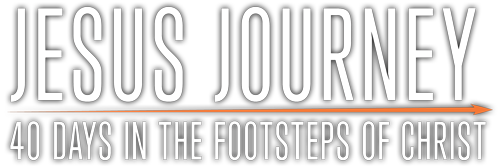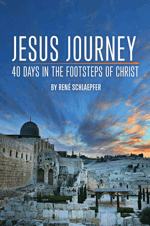Day 18
Of Windmills and Figs
Read Mark 11:12–18
Minarets. Domed churches. Palm trees.
I’d expected to see those shapes silhouetted against the Jerusalem sky, but not what I’m seeing now.
A giant windmill. It looks like it was transported directly from Holland.
Our guide Kenny sees my confusion and explains. It’s no mirage. It was built in 1857 to be a real, working mill. European Jews like the noted British philanthropist Sir Moses Montefiore were just beginning to take an interest in the plight of their impoverished brethren in Jerusalem in the 1800s, and often imported distinctly European solutions.
In this case, Montefiore decided to improve the outdated, donkey-and-millstone method for milling grain by hiring the best industrial designers in Britain, the Holman Brothers of Canterbury, to build a modern windmill.
It was the tallest structure outside the old city, at five stories high. It used the latest technology of the time, four patent sails. The entire top portion could actually be turned to face the wind. Each piece was laboriously imported from England, transported from the harbor at Jaffa by camel.
It was probably the most advanced windmill on earth when it was built.
But it never worked. Why? The builders had thought of everything, sparing no expense.
There was only one more little thing they needed.
Wind.
Small oversight: There are rarely windy conditions in this part of town.
So it stands tall and proud, looking great. It’s still a landmark for tourists navigating Jerusalem’s streets. But it never produced grain.
It reminds me of a confusing episode in the life of Christ.
I’ll admit it: Jesus’ cursing of the fig tree is one of those events that has made me feel awkward about him.
The Bible says Jesus is hungry and sees a fig tree in the distance in full leaf (Mark 11:13). Then he seems to get upset when there’s nothing on the tree to eat and pronounces judgment on it, even though Mark points out that it wasn’t even fig season yet.
On the surface this seems petulant. But this isn’t about Jesus wanting a snack. It’s about Jesus memorably showing what was wrong with the temple system. Looked great. No fruit.
See, even before fig season, the trees produce little knobs. I noticed them all over the fig trees when I was there. Arabs call these taqsh.
Passers-by can snap off taqsh to eat if they’ve got the munchies. But if leaves appear in the spring without any taqsh, that’s an indication there will be no figs on that tree that year. As famous New Testament scholar F. F. Bruce put it, “For all its fair foliage, it is a fruitless tree.” 28
ALL LEAVES, NO FRUIT
Context: This happens just outside Jerusalem during the week before Christ’s crucifixion. He’s on his way into town, walking toward the Temple, which looms impressively in front of him. During his time there, the disciples will point out to him the beauty of the Temple and its buildings — and they were beautiful.
The first temple had been built by Solomon about one thousand years before Christ. Then in 586 BC that building was destroyed by the Babylonians. After seventy years, the Jews in Jerusalem began rebuilding a temple, but their rather meager construction was completely remodeled on an awesome, grand scale by King Herod.
His goal? For the Temple to outshine any other building in the world. It would be bigger, more lavish, more colorful, and more spectacular than anything in Egypt, Greece, Babylon or Rome.
His mission was accomplished. In Jesus’ day, primary construction was finished, and only a few details were still to be completed. After decades of work, the glorious Temple complex was sparkling and impressive.
The Roman historian Tacitus describes the Temple as “possessing enormous riches” and the first-century writer Josephus said the marble, tile, and limestone Temple Mount was “like a snowy mountain glittering in the sun.” It was massive, capable of holding one million people during their religious pilgrimages. 29
But, Jesus is saying, it’s all leaves, no fruit.
He is echoing a theme from the earlier Hebrew prophets. In Hosea, God says that Israel showed so much promise early on — but then abandoned God for false religion. And look at the metaphor:
When I found Israel, it was like finding grapes in the desert; when I saw your fathers, it was like seeing the early fruit on the fig tree. But when they came to Baal Peor, they consecrated themselves to that shameful idol and became as vile as the thing they loved… Ephraim is blighted, their root is withered, they yield no fruit… Hosea 9:10, 16
The fig tree Jesus found on the way into town was the perfect visual metaphor. Jesus wasn’t being impulsive. He wasn’t upset that he didn’t get a snack. He was giving a memorable warning.
The Temple had a great design. The religious system was meticulously precise. But it was form without function.
Fig tree without figs.
Windmill without wind.
Same problem.
A great look holds great promise. However the essential component is missing. It’s big and beautiful and broken.
And this isn’t a topic he’s just now introducing. Back in the Sermon on the Mount, Jesus gave a gauge to measure Bible teachers and preachers. Most of us judge teachers by their abilities, their gifts and charisma. But Jesus recommends a different measure: “By their fruit you will know them.”
(Matthew 7:16)
They may be trees in full glorious leaf. But show me the fruit! Are they producing love, joy, peace — in their own lives and the lives of their followers?
And ask yourself: What about me? I may be leafy with activity, or words. But where’s the fruit?
As he continues to attack the strict yet shallow spirituality of the Pharisees, Jesus will soon use what may be his most stunning and offensive metaphor.
Ponder
What does the “fruit” of your life over the last few days tell you about your relationship with Jesus?

 Buy Jesus Journey at Amazon.com
Buy Jesus Journey at Amazon.com